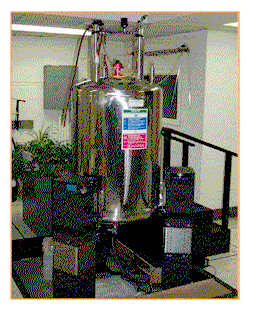Introduction
Definition of Life
Motivation
Preliminary
Steps
Present Life
Past Life
Geological Survey
Sample Collection
Spectroscopic Analysis
Organic Analysis
Biology Experiments
Thin Section
Isotope Analysis
Experimental Design
Nuclear Magnetic Resonance Spectroscopy
The nuclei of all elements carry a charge. When the spins of the protons and neutrons comprising these nuclei are not paired, the overall spin of the charged nucleus generates a magnetic dipole along the spin axis. The absorption of frequencies is plotted and a NMR spectrum is produced which can be analyzed to give the exact molecular structure of the sample. Some of the functions of NMR Spectroscopy include (http://www.ch.ic.ac.uk/local/organic/nmr_scope.html):
-
High resolution mode on homogenous solutions
-
High power mode on highly relaxing nuclei which exhibit very broad lines, or polymers etc.
-
The study of solids
-
NMR 3D imaging to resolutions of ~ 1 mm
-
Functional group analysis (chemical shifts)
-
Bonding connectivity and orientation (J coupling)
-
Through space connectivity (Overhauser effect)
-
Molecular Conformations, DNA, peptide and enzyme sequence and structure
-
Chemical dynamics (Lineshapes, relaxation phenomena)
In addition to immediate analysis of organic compounds, NMR spectroscopy is able to perform time-lapsed real-time molecular determination, reaction rates, etc. that is useful to see how a sample changes over time.
- Analytical Information from NMR: Organic structural identification – gives exact structure of compounds; tuned to frequency based on protons, but is adjustable.
- Sample Requirements for NMR: Prepared liquid is easiest and most common, but solid state NMR is possible. Liquid samples need to be in a reference solution – usually tetramethylsilane (TMS) or heavy water.
- Supplemental Information: Typical Analysis time - <1 hour the analysis and interpretation of a sample. More complex samples will require additional time for interpretation.
A high frequency (strong magnet) is necessary to achieve a high level of detail and precision, yet the higher the frequency, the larger and more cumbersome the magnet. Something along the order of 250 MHz. is acceptable for our mission assuming the compounds we look at won’t be super-complex. This strength is more than adequate for 90% of common molecules. A Fourier-Transfer (FT) component is absolutely necessary for NMR spectroscopy. It makes all of the preliminary analysis automated and significantly speeds up any sort of computation. A supply of helium needed to cool the magnet and the probe is also required. Picture of 500 MHz. system (significantly larger than 250 MHz.) (http://www.eecs.uic.edu/~gary/NMR/minNMR/):

The NMR Spectrometer, due to its size and relative difficulty in surface transportation, will be located in the habitat.